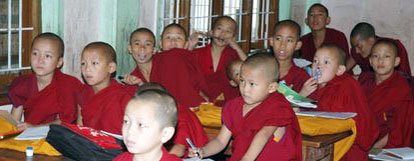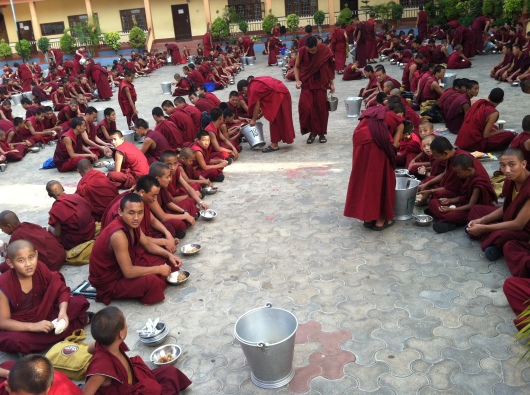This post contains material from Dr. Pierce’s blog, https://piscience.wordpress.com/, written after his India trip in 2016.
A common question upon returning from my trip concerned the food. Fortunately (for me, anyway), we ate at the monastery hotel and not the typical monk fare. I’m sure I could’ve handled the food the monks ate, which was just a vegetarian rice served in mass quantities.
The breakfasts every day were the same and very good. They contained a fried dough that was pita-like, an egg soup with some potato, and a semi-spicy potato dish. There were also boiled eggs and bread with condiments, but I stuck to something that looks like the picture below. I went with the black tea (no milk!) and juice, and dipping that bread in the soup and using it to pick up the potatoes was ridiculously tasty.
The lunches and dinners varied, and we went out to eat Tibetan/Chinese food at a restaurant one night and Indian food another. Unfortunately I didn’t play the part of the obnoxious American, taking pictures of the food, but I was able to find something close on Google. The lunches and dinners at the hotel in the monastery usually consisted of a variety of vegetable dishes and tingmo, the Tibetan Steamed bread shown below. After eating it for a couple days, though, I couldn’t handle it anymore (not sure why, maybe it was too bland?) so I went with just a couple veggie dishes for lunch.
The best Tibetan dish I had was momos, which are fried or steamed dumplings with veggies or meat inside. They are served with a spicy condiment, like the one below, and the fried ones have that crispy outside and savory middle — just fantastic. We were told that “traditional Tibetan food” wasn’t very good, consisting of raw meat among other things, and the food that we were served was more of a Tibetan/Chinese hybrid. Whatever it was, it was outstanding.

We stopped several times for Indian food, which included masalas, biryani, paneer, and tandoori. All served with delicious naan and all delicious. I’ll spare the internet pictures on these (as they are fairly ubiquitous now in the US) and just show my first dish, a masala omelette. I wasn’t super ambitious, taking the advice of Emory’s TravelWell and avoiding any raw fruit or vegetables that have edible skin. I didn’t get sick except for some stomach issues that I curbed quick with Imodium AD, so I’d keep this strategy in the future. The food was a highlight of the trip, though, and I’m salivating for those fried momos as I write. Maybe I’ll try to make them soon!

















